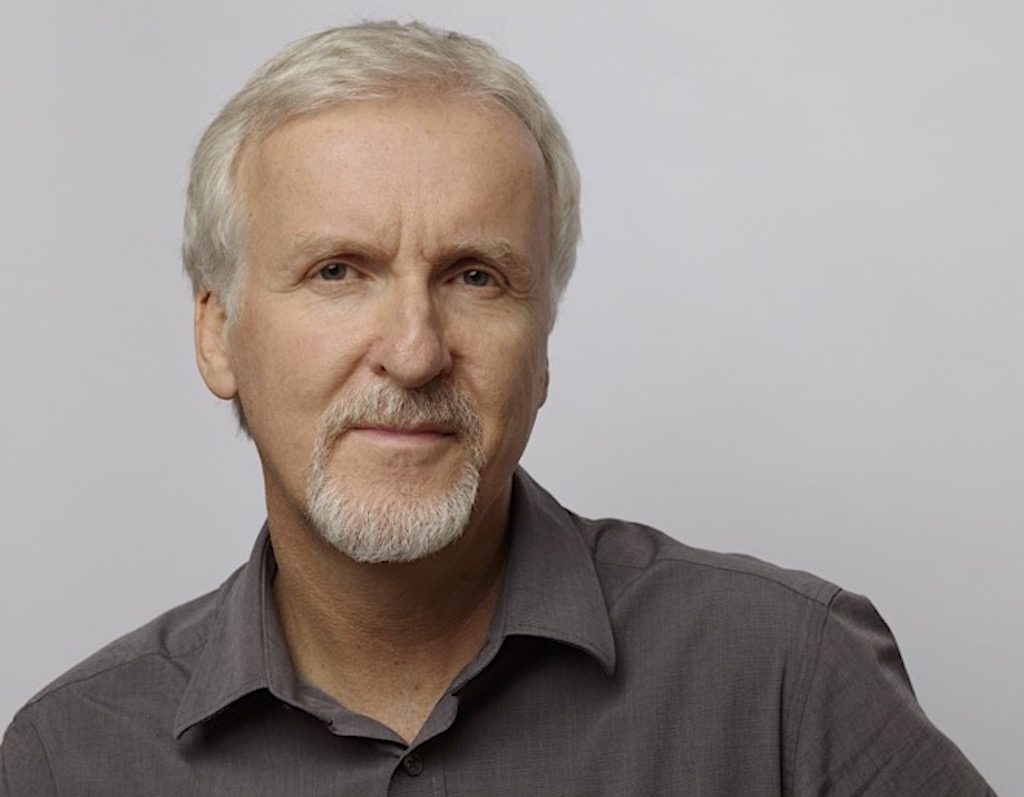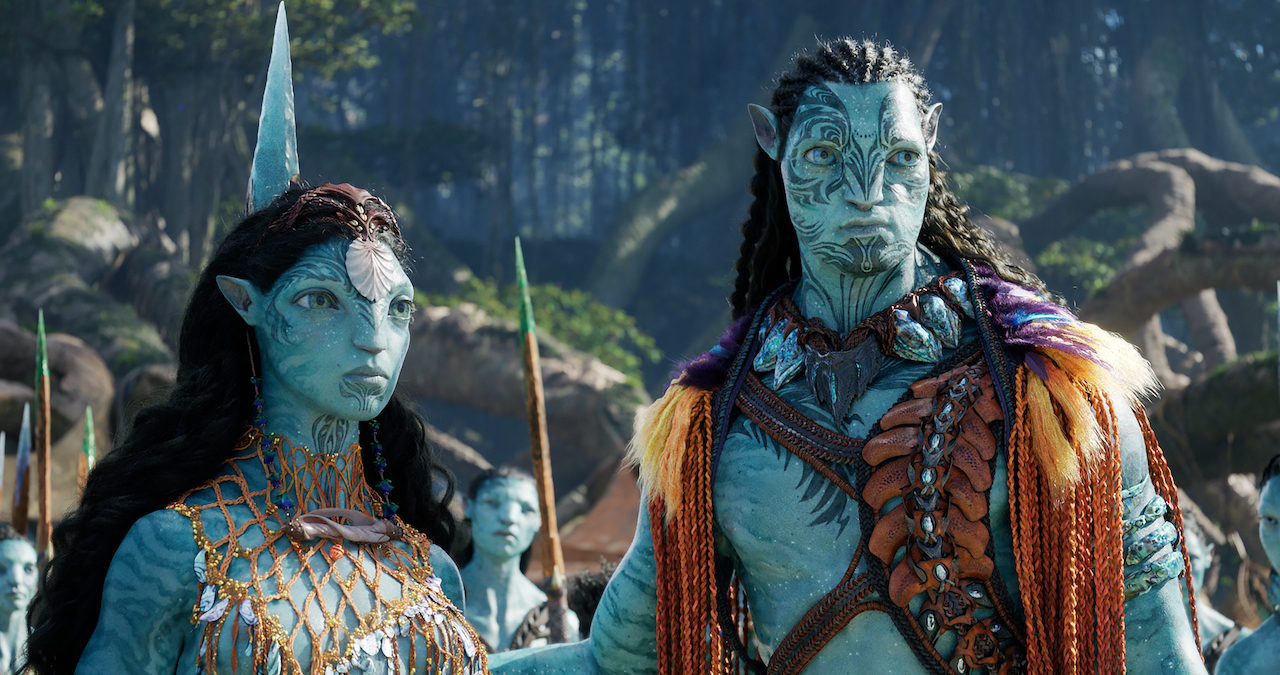- James Cameron, Rick Jaffa & Amanda Silver On “Avatar: The Way Of Water” (Part 1)
- James Cameron, Rick Jaffa & Amanda Silver On “Avatar: The Way Of Water” (Part 2)
The Avatar ecosystem has been swirling around for decades. In 1994, James Cameron wrote an eighty-page treatment for his futuristic science fiction vision. Wrapped up in that technological wizardry was a love story between a human avatar Jake Scully (Sam Worthington) and Neytiri (Zoe Saldana) daughter of previous Ne’vi clan chief.
It wasn’t until 2009, after the required cutting-edge technology caught up, that Avatar was finally released to adoring fans. Cameron instinctively knew his epic opus had legs, so he concurrently recruited screenwriters Josh Friedman, Shane Salerno, Rick Jaffa and Amanda Silver to flesh out the story into three or possibly four films. Over a decade later, the followup titled Avatar: The Way Of Water hit our screens. The fans rushed back to the theaters, knowing that the wait was worth it. Writer/ director James Cameron, and screenwriters Rick Jaffa and Amanda Silver spoke with Creative Screenwriting Magazine about creating cinematic history by writing about pieces of their own lives.
The initial thematic of Avatar has remained intact – one of imperialism and respecting our environment. “I think the message has just been refocussed. It’s as timely as ever as the human race confronts our heavy burdensome footprint on the world,” said Cameron. The Way Of Water is not concerned with destructively mining unobtainium with no controls. “We’re focusing on the ocean. It’s a little more specific. We’re dealing less with colonial themes and more about the direct exploitation of the ocean,” Cameron iterated.
Our rapacious harvesting of the seas has been going on for generations. Just because we’ve lived with uncontrolled capitalism all our lives, we shouldn’t simply accept it. “We’ve taken over ninety percent of the apex species out of the ocean,” Cameron warned. This transcends nationality, religion, culture, and creed.
Despite his concerns over the severe reduction of marine biomass caused by human activity, James Cameron contends that The Way Of Water is primarily a piece of entertainment. “It’s not meant to be preachy. But if people can still get angry and be traumatized by the death of the mother Tulkun (large sea mammals with huge spiritual significance for the Metkayina clan), then the movie reminds us of the real world we have a responsibility toward and duty to protect.”
Co-writers Rick Jaffa and Amanda Silver spent a good deal of time discussing our oceanic degradation during their story meetings with James Cameron. But ecology was only part of the Avatar equation. “Ultimately, we wanted to tell truths that could be reduced into relatable characters, their relationships and their dynamics,” added Jaffa. “The Way Of Water is a story about family.”
We designed an exemplar of a whale to make a statement about the state of the ocean. “Who doesn’t think an alien whale isn’t an exciting character?” quipped Cameron. The next step was deciding who was going to have the relationship with the Tulkun. It was Payakam (Britain Dalton), the outcast son. This added questions regarding why he became an outcast. “He’s having problems with his father and brother. He’s misunderstood and driven out of his community,” he continued.
You have a thematic challenge and solve it through character – James Cameron
Avatar has no shortage of story. Even with a running time of over three hours, it has a dense, swiftly-paced storyline. “It’s a very high class problem to have so much material that you want to delve into,” stated Amanda Silver. “One of the challenges in the writers’ room was letting go of certain things while weaving all these storylines together in a way that was gripping, but not didactic.” The Way Of Water explores extended family – human, hybrid, Na’vi, plant and animal. “Every member of the Sully family has a story to tell. We had to keep all those stories alive and firing on all cylinders. We also focused on what each character was feeling and the audience’s relationship to these characters,” Silver continued.
The writers were well-aware of the action and spectacle that Avatar delivered, but “the characters are the essence of everything,” she added. Jaffa and Silver have been members of the Avatar family since the beginning. Despite being helmed by James Cameron, they were given great creative freedom to craft their characters. “We had a lot of challenges in the first pages in terms of setting up the world of Jake and Neytiri, how they came together, and what’s the new normal in their world? Then we had to bring in the humans headed by Miles Quaritch (Stephen Lang),” continued Jaffa.

James Cameron. James Cameron. Photo courtesy 20th Century Studios
Cameron was acutely aware of the vast amount of story terrain, but he was hesitant to bring out the axe too early. “Let’s just go for it and see where it takes us,” he proclaimed. “We blew up and then we faced the discipline of coming down.” This editing process continued until the film was screened.
We let ourselves off the leash to explore – James Cameron
The Writing Process
“The first draft is always the writers, the second draft is the shooting, and the third draft is the editing,” Cameron said. A key component of the mercurial nature of screenwriting is that, “audiences don’t remember movies the way we write them. They remember a series of glowing vignettes and moments.” These moments can be as seemingly innocuous as “a single line of dialogue or a single gesture… a single interaction between two characters.” This allows the story to move towards a narrative goal and doesn’t require the strong hand of the screenwriter steamrolling it. “Let it be open and breathe.” Those little intimate story nuggets are most memorable to the audience so writers should protect them at all costs.
A movie with a rich a narrative as Avatar: Way Of Water still requires a rigid editing of the story even if it runs at over three hours. “Find your greatest hits that you can’t take out and work around them.” Writers need to leapfrog over the non-crucial story elements so their characters jump from A to G without the intermediate steps. “Can the audience make those cognitive leaps with us?,” asked Cameron. It’s kneading story dough – spreading out, rolling up, and kneading some more. It’s a continuous process of contraction and expansion.
The Avatar juggernaut began as a treatment in the 1990s containing both broad strokes and tiny moments. Rick Jaffa and Amanda Silver wrote sections of the treatments for the first four Avatar films. The stories were interchangeable between them. The first act of Way Of Water eventually expanded out into three films.
Writing those treatments was an immediate meeting of the minds,” claimed Jaffa. “Over the course of the time in the writers’ room, we were cooking on all cylinders and working as a collective mind.” It was a six month process to write Avatar: Way Of Water.
“We all had our favourite font we’d write in. Then we through all our bits and pieces together. Our treatments look like CRISPR gene splicing,” added Cameron.
